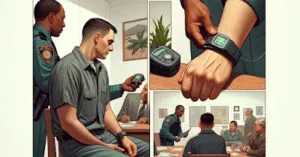Parolees, after serving a portion of their sentence, re-enter society with hopes of a fresh start. One of the common images associated with parole is the ankle monitor – an image popularized by countless movies and TV shows. But how accurate is this representation?
Navigating the complexities of parole often leads us to ask about the conditions attached. Let’s delve into the world of parole and the place ankle monitors have in it.
Do You Get an Ankle Monitor for Parole?
Whether or not you get an ankle monitor for parole depends on several factors, including the severity of your crime, your risk of re-offending, and the laws of the jurisdiction in which you are being paroled.

In many jurisdictions, ankle monitors are used to track people who are on parole for serious offenses, such as violent crimes or drug trafficking. Ankle monitors may also be used to track people who are on parole for less serious offenses, but who are considered to be at a high risk of re-offending.
The decision of whether or not to require an ankle monitor for parole is typically made by a parole board or a parole officer. The parole board or parole officer will consider some factors, including the person’s criminal history, their risk of re-offending, and their plans for reintegrating into society.
If you are required to wear an ankle monitor for parole, you will need to comply with all of the terms and conditions of your parole. This may include wearing the monitor at all times, following a curfew, and staying away from certain areas or people.
Ankle monitors can be a helpful tool for managing people who are on parole. They can help to ensure that people are complying with the terms of their parole and that they are not a threat to public safety. However, ankle monitors can also be uncomfortable and inconvenient to wear.
Understanding Parole
-
What’s Parole Anyway?
- Think of parole as a trial period. It lets inmates live outside prison but under strict conditions.
-
Why Grant Parole?
- It’s a second chance. Offering inmates an opportunity to rebuild their lives, while being supervised.
The Ankle Monitor: Unveiled
-
A Quick Look:
- These are devices worn around the ankle. They use GPS to track the wearer’s location.
-
Who Gets Them?
- It’s a myth that every parolee gets one. Their use is based on factors like the nature of the crime and perceived risk.
- For instance, a first-time offender with a minor crime might not get one. But someone with a record might.
Ankle Monitors: The Good and The Bad
-
On The Plus Side:
- They help track parolees, ensuring they stick to conditions.
- Deter parolees from re-offending.
- Offer the public some peace of mind.
-
The Downsides:
- Some find them invasive.
- They can malfunction, leading to false alarms.
- Physical discomfort or skin issues for the wearer.
Common Misconceptions
-
Everyone on Parole Gets One
- Not true. It’s based on individual assessments.
-
They’re Flawless
- Nope. Like any tech, they have their glitches.
Wrapping Up
Ankle monitors, while a significant tool in monitoring some parolees aren’t as ubiquitous as pop culture might have us believe. Knowing the facts helps in understanding the broader parole system, dispelling myths, and promoting informed discussions.